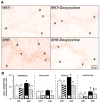Proteinase activity and receptor cleavage: mechanism for insulin resistance in the spontaneously hypertensive rat
- PMID: 18606910
- PMCID: PMC2677556
- DOI: 10.1161/HYPERTENSIONAHA.107.104356
Proteinase activity and receptor cleavage: mechanism for insulin resistance in the spontaneously hypertensive rat
Abstract
Arterial hypertension is associated with organ dysfunctions, but the mechanisms are uncertain. We hypothesized that enhanced proteolytic activity in the microcirculation of spontaneously hypertensive rats (SHRs) may be a pathophysiological mechanism causing cell membrane receptor cleavage and examine this for 2 different receptors. Immunohistochemistry of matrix-degrading metalloproteinases (matrix metalloproteinase [MMP]-9) protein shows enhanced levels in SHR microvessels, mast cells, and leukocytes compared with normotensive Wistar-Kyoto rats. In vivo microzymography shows cleavage by MMP-1 and -9 in SHRs that colocalizes with MMP-9 and is blocked by metal chelation. SHR plasma also has enhanced protease activity. We demonstrate with an antibody against the extracellular domain that the insulin receptor-alpha density is reduced in SHRs, in line with elevated blood glucose levels and glycohemoglobin. There is also cleavage of the binding domain of the leukocyte integrin receptor CD18 in line with previously reported reduced leukocyte adhesion. Blockade of MMPs with a broad-acting inhibitor (doxycycline, 5.4 mg/kg per day) reduces protease activity in plasma and microvessels; blocks the proteolytic cleavage of the insulin receptor, the reduced glucose transport; normalizes blood glucose levels and glycohemoglobin levels; and reduces blood pressure and enhanced microvascular oxidative stress of SHRs. The results suggest that elevated MMP activity leads to proteolytic cleavage of membrane receptors in the SHR, eg, cleavage of the insulin receptor-binding domain associated with insulin resistance.
Conflict of interest statement
Figures









Comment in
-
Metalloproteinases damage the insulin receptor to cause insulin resistance in spontaneously hypertensive rats.Hypertension. 2008 Aug;52(2):215-7. doi: 10.1161/HYPERTENSIONAHA.107.108902. Epub 2008 Jun 9. Hypertension. 2008. PMID: 18541734 No abstract available.
References
-
- Suematsu M, Suzuki H, Delano FA, Schmid-Schönbein GW. The inflammatory aspect of the microcirculation in hypertension: oxidative stress, leukocytes/endothelial interaction, apoptosis. Microcirculation. 2002;9:259–276. - PubMed
-
- Kobayashi N, DeLano FA, Schmid-Schönbein GW. Oxidative stress promotes endothelial cell apoptosis and loss of microvessels in the spontaneously hypertensive rats. Arterioscler Thromb Vasc Biol. 2005;25:2114–2121. - PubMed
-
- Lenda DM, Sauls BA, Boegehold MA. Reactive oxygen species may contribute to reduced endothelium-dependent dilation in rats fed high salt. Am J Physiol Heart Circ Physiol. 2000;279:H7–H14. - PubMed
-
- Sechi LA, Griffin CA, Giacchetti G, Zingaro L, Catena C, Bartoli E, Schambelan M. Abnormalities of insulin receptors in spontaneously hypertensive rats. Hypertension. 1996;27:955–961. - PubMed
-
- Morisco C, Condorelli G, Orzi F, Vigliotta G, Di Grezia R, Beguinot F, Trimarco B, Lembo G. Insulin-stimulated cardiac glucose uptake is impaired in spontaneously hypertensive rats: role of early steps of insulin signalling. Journal of Hypertension. 2000;18:465–473. - PubMed
Publication types
MeSH terms
Substances
Grants and funding
LinkOut - more resources
Full Text Sources
Other Literature Sources
Medical
Miscellaneous

